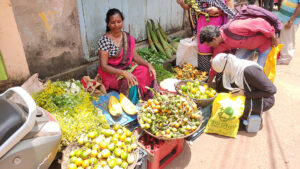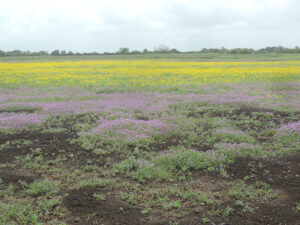The dilemma between the conservation of tradition and natural resources needs to be addressed by creating awareness about the effects of harvesting plants in large quantities, regulating commercialization and framing ecological ethics to ultimately protect the human-nature interconnection.
Here’s a summary of a Paper on Matvi – An Eco-Cultural Tradition of Wildflower Decoration from Rajapur Tehsil, Ratnagiri Dist., Maharashtra by Pooja Ghate, Manali Rane and Aparna Watve from the Bombay Environmental Action Group (BEAG).
The term ‘eco-cultural tradition’ can be defined as a folk practice followed and transferred over generations with the inclusion of diverse interactions between humans and the natural environment which combine ecological and cultural aspects of a landscape together.
Matvi or mandapi is an eco-cultural tradition practised in the Ratnagiri district of Maharashtra where wild flowers and fruits are arranged on a wooden square or rectangular frame and tied to the roof above the idol of Lord Ganesha during the Ganesh festival. Similar practice is observed under different vernacular names such as ‘mati-mhalyar mandap’, ‘mantap’ or ‘matov’ in the neighbouring districts of Sindhudurg and Goa State.
Regular visits to the study area were conducted in eight villages from August to September 2022, and we observed that the plants used in the matvi decorations were collected from the lateritic plateau, i.e. sadas, located around them. These plateaus have diverse habitats such as open grassland, pockets of scrub vegetation, and bare rocks. Locals from six villages never purchased and always collected plants directly from the plateau due to its proximity and accessibility from homesteads. In one village, people collected only Impatiens rosea and Senecio bombayensis from the plateau and purchased other plants from the local market.
Field visits were conducted a day prior to Ganesh Chaturthi to record collections of natural plant material for matvi decoration and to get insights about sources of plant material used, changes in the practices and any other similar traditions followed at the household level. A total of 10 species are used in the decoration of matvi of which three species are cultivated and the remaining 7 are wild.
A day prior to Ganesh festival, we visited the local market in Rajapur town to note the plant resources sold for matvi decoration. Our observations showed that ritualistic offerings of patri (leaves) and wildflowers collected from surrounding landscapes were a component of all worship. But matvi differs in one significant aspect, that the plants are neither worshipped nor offered to the deities but are primarily used to decorate the sacred space.
The designated space where the idol of Lord Ganesha is placed during the festival becomes a sacred space till the immersion of the idol and is decorated by family members prior to the arrival of Lord Ganesha. A square or rectangular wooden frame called matvi is hung exactly above the Ganesh idol and is laden with locally available plants, flowers and fruits.
The plant material termed ‘fulora’, roughly translated as ‘blooms’ or ‘Sonaki’ (Senecio bombayensis), is generally collected the day before Ganesha Chaturthi and hung on the matvi.
The fruit of Cocos nucifera and leaves of Mangifera indica are tied first as they are considered auspicious in all Hindu rituals.
Artificial garlands and flowers are also used with natural material indicating a cultural shift. Once matvi decoration is complete, it strictly remains as it is till the departure of Lord Ganesha. Fresh natural elements are not added or replaced even if they have dried out.
However, this practice and the plants are facing threats. Matvi in its original form is followed in rural areas. Urban and peri-urban regions are replacing decoration with plastic replicas as the younger generation residing in metropolitan areas visiting their villages for the festival may not be connected with this tradition. Habitat shrinkage, clearing of vegetation, excessive use of pesticides, and fire are potential threats to these plant species.
Link to the Paper












